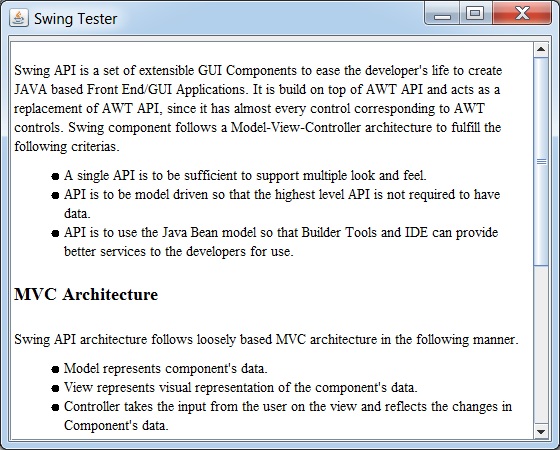Swing 示例 - 使用 JEditorPane 显示 HTML 页面
以下示例展示了如何在基于 Swing 的应用程序中显示 HTML 文件的 HTML 内容。
我们使用以下 API。
JEditorPane − 创建一个编辑器框来显示 HTML 内容。
jEditorPane.setPage(URL url) − 从传递的 url 获取 HTML 并显示。
示例
让我们在 SwingTester.java 所在的当前目录中创建一个 html 文件 test.htm。
test.htm
<html>
<head>
<title>Swing Tester</title>
</head>
<body>
<p>Swing API is a set of extensible GUI Components
to ease the developer's life to create JAVA based Front End/GUI
Applications. It is build on top of AWT API and acts as a replacement of
AWT API, since it has almost every control corresponding to AWT controls.
Swing component follows a Model-View-Controller architecture to
fulfill the following criterias.</p>
<ul>
<li><p>A single API is to be sufficient to support multiple look and feel.</p></li>
<li><p>API is to be model driven so that the highest level API is not required to have data.</p></li>
<li><p>API is to use the Java Bean model so that Builder Tools and IDE can provide better services to the developers for use.</p></li>
</ul>
<h2>MVC Architecture</h2>
<p>Swing API architecture follows loosely based MVC architecture in the following manner.</p>
<ul>
<li><p>Model represents component's data.</p></li>
<li><p>View represents visual representation of the component's data.</p></li>
<li><p>Controller takes the input from the user on the view and reflects the changes in Component's data.</p></li>
<li><p>Swing component has Model as a seperate element, while the View and Controller part are clubbed in the User Interface elements. Because of which, Swing has a pluggable look-and-feel architecture.</p></li>
</ul>
<h2>Swing Features</h2>
<ul>
<li><p><b>Light Weight</b> − Swing components are independent of native Operating System's API as Swing API controls are rendered mostly using pure JAVA code instead of underlying operating system calls.</p></li>
<li><p><b>Rich Controls</b> − Swing provides a rich set of advanced controls like Tree, TabbedPane, slider, colorpicker, and table controls.</p></li>
<li><p><b>Highly Customizable</b> − Swing controls can be customized in a very easy way as visual apperance is independent of internal representation.</p></li>
<li><p><b>Pluggable look-and-feel</b> − SWING based GUI Application look and feel can be changed at run-time, based on available values.</p></li>
</ul>
</body>
</html>
SwingTester.htm
import java.awt.BorderLayout;
import java.awt.Dimension;
import java.awt.FlowLayout;
import java.awt.LayoutManager;
import java.io.IOException;
import java.net.URL;
import javax.swing.JEditorPane;
import javax.swing.JFrame;
import javax.swing.JPanel;
import javax.swing.JScrollPane;
public class SwingTester {
public static void main(String[] args) {
createWindow();
}
private static void createWindow() {
JFrame frame = new JFrame("Swing Tester");
frame.setDefaultCloseOperation(JFrame.EXIT_ON_CLOSE);
createUI(frame);
frame.setSize(560, 450);
frame.setLocationRelativeTo(null);
frame.setVisible(true);
}
private static void createUI(final JFrame frame){
JPanel panel = new JPanel();
LayoutManager layout = new FlowLayout();
panel.setLayout(layout);
JEditorPane jEditorPane = new JEditorPane();
jEditorPane.setEditable(false);
URL url= SwingTester.class.getResource("test.html");
try {
jEditorPane.setPage(url);
} catch (IOException e) {
jEditorPane.setContentType("text/html");
jEditorPane.setText("<html>Page not found.</html>");
}
JScrollPane jScrollPane = new JScrollPane(jEditorPane);
jScrollPane.setPreferredSize(new Dimension(540,400));
panel.add(jScrollPane);
frame.getContentPane().add(panel, BorderLayout.CENTER);
}
}
输出

 swingexamples_editorpanes.html
swingexamples_editorpanes.html

